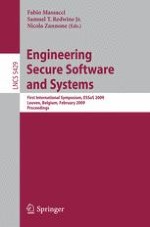2009 | Buch
Engineering Secure Software and Systems
First International Symposium ESSoS 2009, Leuven, Belgium, February 4-6, 2009. Proceedings
herausgegeben von: Fabio Massacci, Samuel T. Redwine Jr., Nicola Zannone
Verlag: Springer Berlin Heidelberg
Buchreihe : Lecture Notes in Computer Science
